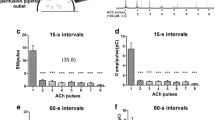Abstract
Exposure of rat pheochromocytoma (PC12) cells to cyanide produces elevation of cytosolic calcium, impaired Na+−H+ exchange, membrane lipid peroxidation and release of neurotransmitters. Since these observations suggested cyanide alters plasma membrane function, the present study examined the effect of NaCN on the membrane potential of undifferentiated PC12 cells in suspension. In PC12 cells loaded with the voltage sensitive fluorescent dye, bis-oxonol, cyanide (2.5–10 mM) elicited an immediate (within seconds), concentration related decrease in fluorescence, indicating hyperpolarization of the plasma membrane. Increasing extracellular K+ concentration to 20 mM blocked the effect of cyanide (5 mM), suggesting cyanide increased K+ efflux. Pretreatment with quinine blocked the cyanide-induced hyperpolarization, whereas glyburide had little effect, showing the hyperpolarization produced by cyanide was due to activation of Ca2+ sensitive K+ channels. Removal of Ca2+ from the media did not influence cyanide-induced hyperpolarization. However, buffering intracellular Ca2+ by loading cells with the Ca2+ chelators, Quin II or BAPTA, abolished the cyanide effect, showing cytosolic Ca2+ is a key factor. These findings suggest that cyanide mobilizes Ca2+ from intracellular stores which leads to hyperpolarization via the activation of Ca2+ sensitive K+ channels.
Similar content being viewed by others
References
Ardelt BK, Borowitz JL, Isom GE (1989) Brain lipid peroxidation and antioxidant defense mechanisms following acute cyanide intoxication. Toxicology 56: 147–154
Armando-Hardy M, Ellory JC, Ferreira HG, Fleminger S, Lew VL, (1975) Inhibition of the calcium-induced increase in the potassium permeability of human red blood cells by quinine. J Physiol 250: 32P-33P
Auclair MC, Adolphe M, Moreno G, Salet C (1976) Comparison of the effects of potassium cyanide and hypoxia on ultrastructure and electrical activity of cultured rat myoblasts. Toxicol Appl Pharmacol 37: 387–399
Duchen MR (1990) Effect of metabolic inhibition on the membrane properties of isolated mouse primary sensory neurons. J Physiol 424: 387–409
Duchen MR, Valdeonillos M, O'Neil SC, Eisner DA (1990) On the regulation of intracellular calcium in isolated mouse sensory neurons. J Physiol 424: 415–427
Fugiwara N, Higashi H, Shimoji K, Yoshimura M (1987) Effects of hypoxia on rat hippocampal neurons in vitro. J Physiol 384: 131–151
Godfraind JM, Kawamura H, Krnjevic K, Pumair R (1971) Actions of dinitrophenol and some other metabolic inhibitors on cortical neurons. J Physiol 215: 199–222
Hansen AJ, Hounsgaard J, Jahnsen H (1982) Anoxia increases potassium conductance in hippocampal nerve cells. Acta Physiol Scand 115: 301–310
Isom GE, Way JL (1976) Lethality of cyanide in the absence of inhibition of liver cytochrome oxidase. Biochem Pharmacol 25: 605–608
Johnson JD, Meisenheimer TH, Isom GE (1986) Cyanide-induced neurotoxicity: role of neuronal calcium. Toxicol Appl Pharmacol 84: 464–469
Johnson JD, Conroy WG, Isom GE (1987) Alteration of cytosolic calcium levels in PC12 cells by potassium cyanide. Toxicol Appl Pharmacol 88: 217–224
Keilin D (1930) Cytochrome and intracellular oxidase. Proc R Soc Lond B 106: 418–444
Kudo Y, Takeda K, Yamazaki K (1990) Quin 2 protects against neuronal cell death due to Ca2+ overload. Brain Res 528: 48–54
Leblond J, Krnjevik K (1989) Hypoxic changes in hippocampal neurons. J Neurophysiol 62: 1–4
Maduh EJ, Borowitz JL, Isom GE (1990a) Cyanide-induced alteration of cytosolic pH: involvement of cellular hydrogen ion handling processes. Toxicol Appl Pharmacol 106: 201–208
Maduh EJ, Borowitz JL, Turek JJ, Rebar A, Isom GE (1990b) Cyanide-induced neurotoxicity: calcium mediation of morphological changes in neuronal cells. Toxicol Appl Pharmacol 103: 214–221
Maduh EU, Borowitz JL, Isom GE (1991) Cyanide-induced alteration of the adenylate energy pool in a rat neurosecretory cell line. J Appl Toxicol 11: 97–101
Murphy KPSJ, Greenfield SA (1991) ATP-sensitive potassium channels counteract anoxia in neurons of the substania nigra. Exp Brain Res 84: 355–358
Patel MN, Yim GKW, Isom GE (1992) Potentiation of cyanide neurotoxicity by blockade of ATP-sensitive potassium channels. Brain Res 593: 114–116
Politi DM, Rogawski MA (1991) Glyburide-sensitive K+ channels in cultured rat hippocampal neurons: activation by chromakalim and energy-depleting conditions. Molecular Pharmacol 40: 308–319
Quast U, Cook NS (1989) Moving together: K+ channel openers and ATP-sensitive K+ channels. Trends Pharmacol Sci 10: 431–435
Reiner PB, Laycock AG, Doll CJ (1990) A pharmacological model of ischemia in the hippocampal slice. Neurosci Lett 119: 175–178
Rink TJ, Montecucco C, Hesketh RR, Tsien RY (1980) Lymphocyte membrane potential assessed with fluorescent probes. Biochem Biophys Acta 595: 15–30
Shafer TJ, Atchison WD (1991) Transmitter, ion channel and receptor properties of pheochromocytoma (PC12) cells: a model for neurotoxicological studies. Neurotoxicology 12: 473–492
Tsein R (1986) New calcium indicators and buffers with high selectivity against magnesium and protons: design, synthesis and properties of prototype structures. Biochemistry 19: 2896–2404
Valenzuela R, Court J, Godoy J (1992) Delayed cyanide induced dystonia. J Neurol Neurosurg Psychiatry 55: 198–199
Wainscott DB, Borowitz JL, Isom GE (1990) Mobilization of intracellular calcium stores by potassium cyanide in PC12 cells. Pharmacologist 32: 161
Author information
Authors and Affiliations
Rights and permissions
About this article
Cite this article
Latha, M.V., Borowitz, J.L., Yim, G.K.W. et al. Plasma membrane hyperpolarization by cyanide in chromaffin cells: role of potassium channels. Arch Toxicol 68, 370–374 (1994). https://doi.org/10.1007/s002040050084
Received:
Accepted:
Issue Date:
DOI: https://doi.org/10.1007/s002040050084




